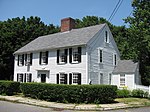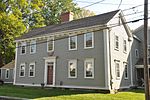Ipswich Camp
Buildings and structures in Ipswich, MassachusettsInstallations of the U.S. Army in MassachusettsMassachusetts building and structure stubs
Ipswich Camp was a former infantry and field artillery coastal defense base camp that existed from between May 1942 and November 1943 in Ipswich, Massachusetts, USA. Company L of the 181st Infantry Regiment was stationed at the camp, alongside Battery B of the 211th Field Artillery Battalion, part of the forces of the Eastern Defense Command for defending the United States. The infantry company patrolled between Newburyport and Lynn, while the field artillery battery was located along several earthwork positions along the coast.
Excerpt from the Wikipedia article Ipswich Camp (License: CC BY-SA 3.0, Authors).Ipswich Camp
Old England Road,
Geographical coordinates (GPS) Address Nearby Places Show on map
Geographical coordinates (GPS)
| Latitude | Longitude |
|---|---|
| N 42.6756 ° | E -70.8269 ° |
Address
Old England Road 15
01938
Massachusetts, United States
Open on Google Maps











